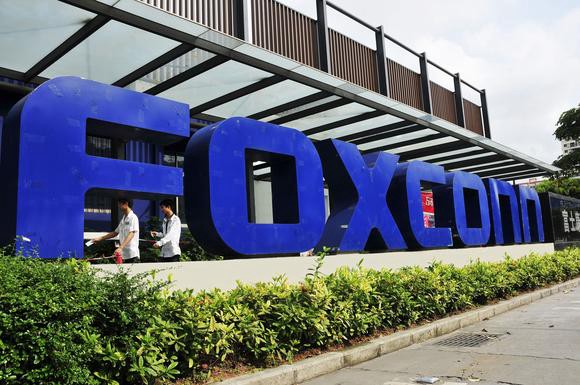
Hint: its not about repatriating old jobs at all.
As President Trump is learning, it’s as so simple as badgering Apple to repatriate manufacturing of the iPhone to the United States. Foxconn, the iPhone’s contract manufacturer suggests that there’s a bigger prize: making the U.S. central to the supply chain for advanced screen display technology, with a large plant here in the U.S. which could add 10-50K jobs. The iPhone is manufactured by Foxconn, a contract manufacturer, which is considering establishing a large display plant here in the U.S. which could add 10-50K jobs.
What’s Under Consideration and Why It’s a Big Deal
Foxconn is considering a $ 7 billion U.S. manufacturing plant for high-end displays with Apple co-investment according to its CEO quoted in Nikki Asian Review:
“The increase in demand for larger display panels makes local production a better solution than shipping from China to the U.S. market.”
While Trump and impending protectionism is cited in the report, the need for this plant seems largely driven by the nature of high value/advanced manufacturing. As the labor component of a product recedes, it’s less worthwhile to manufacture in less expensive regions. Building a U.S. supply chain for displays is a big deal; the report suggests 10,000–50,000 employees. A project this big begets a supply ecosystem, university research to support these advances, and likely leads to related companies and industries for a region. It can be fundamental to the growth and identity of a Maker City or region.
In the same presentation Foxconn’s CEO complains that having to build iPhones in the USA might add $500 to their price. This suggests Foxconn sees advantage in placing high-value facilities in the U.S., but not (low-end) labor intensive projects like iPhone assembly which also call on a range of components not made here. U.S. workers should prefer the high value jobs. Here’s why:
Resiliency Must be Built into Job Creation
Jobs in high-value manufacturing plants are more resilient that lower-value jobs, like assembly, that can be easily be replaced by robots. (Think Carrier). By resilient jobs, we mean jobs that pay at least $20/hour, are part of a local supply chain, and that are part of a broader educational and training effort, to ensure that people can support themselves through a lifetime of work.
Resiliency doesn’t happen alone. It takes an Urban Cluster.
A multi-billion-dollar investment in a display plant has an opportunity to do this. It also asks us to think creatively about how to maximize the multiplier value of an urban cluster. This is a lot more than just a plant with jobs for whatever city gives a good tax/land deal. A smart region working with mayors and a governor can build out research to leverage this, think through how an open ecosystem might encourage experimentation and spin-off use of the technology, ask what complementary companies could be located near by, how students, start-ups and incubators can be engaged. Last year Brookings convened a group of tech companies, manufacturers and makers in the East Bay to explore these implications as they applied to Fremont (home of Tesla), San Leandro, Oakland and San Jose as they become the advanced manufacturing region of Silicon Valley. The opinion piece, Software Eats Manufacturing, and Manufacturing Gains is even more timely today.
My friend Mark Muro at Brookings emphasized this to me:
“I would note that the forces supporting advanced manufacturing localization are really strong now, in part because labor cost arbitrage is less and less important.”
Update from Bloomberg News
Bloomberg adds details, and confirms it’s about a U.S. plant, 10K–50K jobs and in very preliminary stage. Key point: “A potential strategic shift by Foxconn unnerves Chinese authorities because the company employs roughly a million workers across the country.”
Obama made an explicit bid for advanced manufacturing jobs in the US with an investment a national network of advanced manufacturing institutes that sought to increase research, industry, academia, and government partnerships to drive such advance manufacturing outcomes. Trump is more focused on forgotten workers, but will figure out pretty quickly that where highly automated, next-generation plants and supply chains get built is up for grabs, and government policy together with the nature of high-value products can help swing this toward U.S. based plants. As this report makes clear, even a highly-automated plant can lead to plenty of good jobs, and is a multiplier when you consider suppliers, new companies, and education/research. This is what building the future looks like, and where the real battle lies for next-generation manufacturing. As we wrote with Brookings this month, the focus should be on forward-looking ecosystems, not nostalgic plants of yore.
The first inkling of this project was from a photo that Masayoshi Son, chairman of SoftBank Group Corp, held up for reporters after a December meeting with Trump which included the words “Foxconn” and “$7 Billion” alongside SoftBank’s numbers.
Foxconn’s CEO said “I thought it was a private conversation, but then the next morning it was exposed,” Now we are learning more about the project as it’s become a bit more real in Foxconn’s mind.
Relevant Links
- Macrumors: Foxconn is considering a $ 7 billion U.S. manufacturing plant for high-end displays with Apple co-investment
- Bloomberg: Bloomberg adds details, and confirms it’s about a U.S. plant, 10K–50K jobs and in very preliminary stage
- Brookings Institution: Software Eats Manufacturing, and Manufacturing Gains
- Brookings Institution: The Maker Movement Can Catalize a Manufacturing Renaissance
A slightly different version of this post appeared on Medium.
